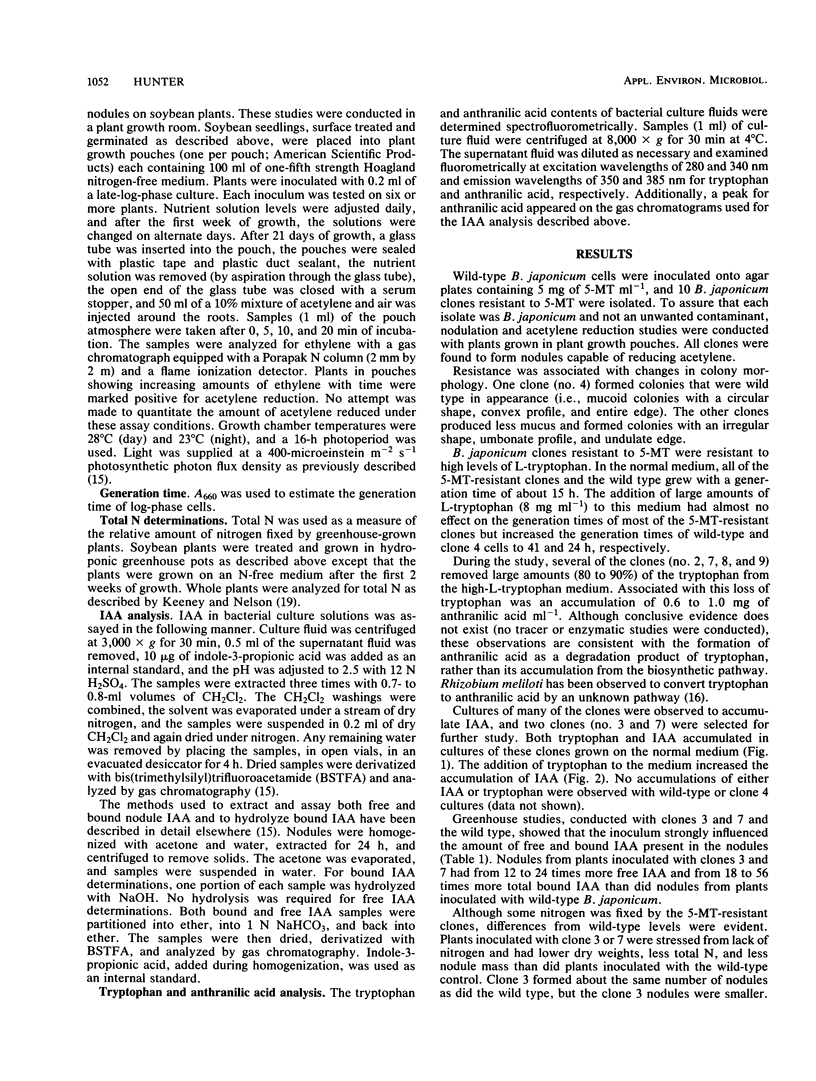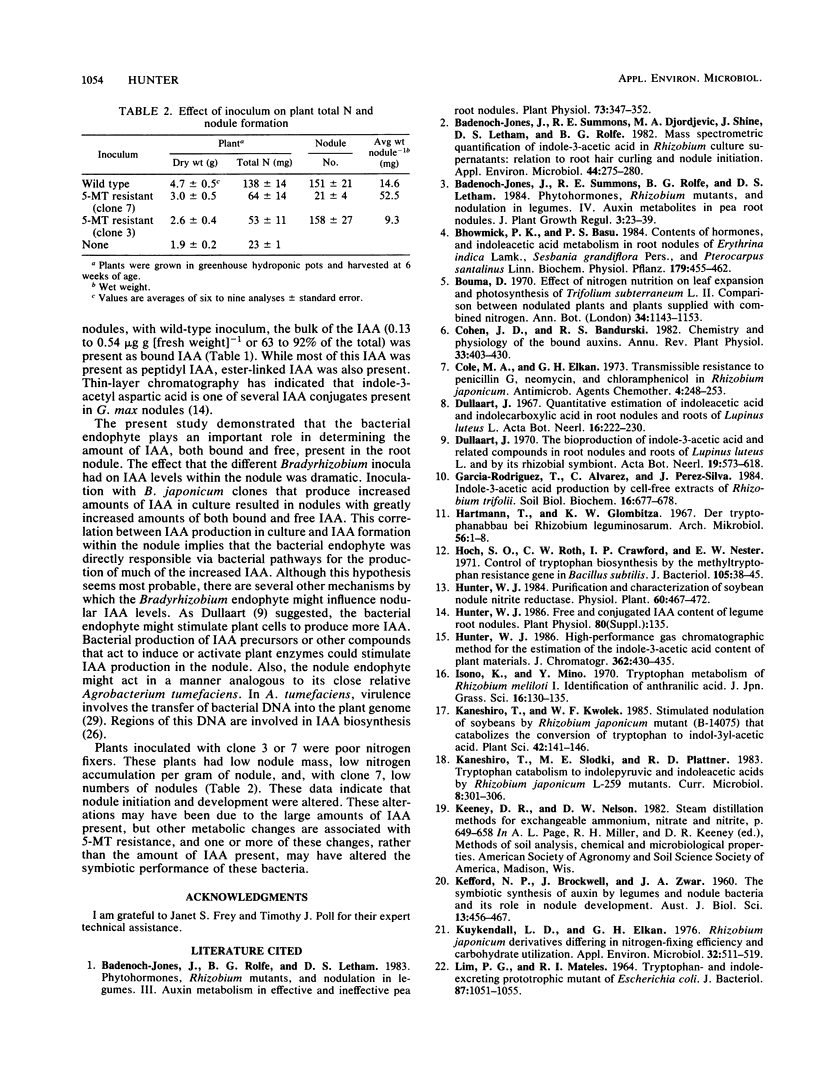Abstract
Bradyrhizobium japonicum mutants resistant to 5-methyltryptophan were isolated. Some of these mutants were found to accumulate indole-3-acetic acid (IAA) and tryptophan in culture. In greenhouse studies, nodules from control plants inoculated with wild-type bradyrhizobia contained 0.04, 0.10, and 0.58 μg of free, ester-linked, and peptidyl IAA g (fresh weight) of nodules−1, respectively. Nodules from plants inoculated with 5-methyltryptophan-resistant bradyrhizobia contained 0.94, 1.30, and 10.6 μg of free, ester-linked, and peptidyl IAA g (fresh weight) of nodules−1, respectively. This manyfold increase in nodule IAA content indicates that the Bradyrhizobium inoculum can have a considerable influence on the endogenous IAA level of the nodule. Further, these data imply that much of the IAA that accumulated in the high-IAA-containing nodules was of bacterial rather than plant origin. These high-IAA-producing 5-methyltryptophan-resistant bacteria were poor symbiotic nitrogen fixers. Plants inoculated with these bacteria had a lower nodule mass and fixed less nitrogen per gram of nodule than did plants inoculated with wild-type bacteria.
Full text
PDF




Selected References
These references are in PubMed. This may not be the complete list of references from this article.
- Badenoch-Jones J., Rolfe B. G., Letham D. S. Phytohormones, Rhizobium Mutants, and Nodulation in Legumes : III. Auxin Metabolism in Effective and Ineffective Pea Root Nodules. Plant Physiol. 1983 Oct;73(2):347–352. doi: 10.1104/pp.73.2.347. [DOI] [PMC free article] [PubMed] [Google Scholar]
- Badenoch-Jones J., Summons R. E., Djordjevic M. A., Shine J., Letham D. S., Rolfe B. G. Mass spectrometric quantification of indole-3-acetic Acid in Rhizobium culture supernatants: relation to root hair curling and nodule initiation. Appl Environ Microbiol. 1982 Aug;44(2):275–280. doi: 10.1128/aem.44.2.275-280.1982. [DOI] [PMC free article] [PubMed] [Google Scholar]
- Cole M. A., Elkan G. H. Transmissible resistance to penicillin G, neomycin, and chloramphenicol in Rhizobium japonicum. Antimicrob Agents Chemother. 1973 Sep;4(3):248–253. doi: 10.1128/aac.4.3.248. [DOI] [PMC free article] [PubMed] [Google Scholar]
- Hartmann T., Glombitza K. W. Der Tryptophanabbau bei Rhizobium leguminosarum. Arch Mikrobiol. 1967 Feb 1;56(1):1–8. [PubMed] [Google Scholar]
- Hoch S. O., Roth C. W., Crawford I. P., Nester E. W. Control of tryptophan biosynthesis by the methyltryptophan resistance gene in Bacillus subtilis. J Bacteriol. 1971 Jan;105(1):38–45. doi: 10.1128/jb.105.1.38-45.1971. [DOI] [PMC free article] [PubMed] [Google Scholar]
- Kuykendall L. D., Elkan G. H. Rhizobium japonicum derivatives differing in nitrogen-fixing efficiency and carbohydrate utilization. Appl Environ Microbiol. 1976 Oct;32(4):511–519. doi: 10.1128/aem.32.4.511-519.1976. [DOI] [PMC free article] [PubMed] [Google Scholar]
- Lim P. G., Mateles R. I. Tryptophan- and indole-excreting prototrophic mutant of Escherichia coli. J Bacteriol. 1964 May;87(5):1051–1055. doi: 10.1128/jb.87.5.1051-1055.1964. [DOI] [PMC free article] [PubMed] [Google Scholar]
- Schröder G., Waffenschmidt S., Weiler E. W., Schröder J. The T-region of Ti plasmids codes for an enzyme synthesizing indole-3-acetic acid. Eur J Biochem. 1984 Jan 16;138(2):387–391. doi: 10.1111/j.1432-1033.1984.tb07927.x. [DOI] [PubMed] [Google Scholar]
- Thimann K. V. On the Physiology of the Formation of Nodules on Legume Roots. Proc Natl Acad Sci U S A. 1936 Aug;22(8):511–514. doi: 10.1073/pnas.22.8.511. [DOI] [PMC free article] [PubMed] [Google Scholar]
- Thomashow L. S., Reeves S., Thomashow M. F. Crown gall oncogenesis: evidence that a T-DNA gene from the Agrobacterium Ti plasmid pTiA6 encodes an enzyme that catalyzes synthesis of indoleacetic acid. Proc Natl Acad Sci U S A. 1984 Aug;81(16):5071–5075. doi: 10.1073/pnas.81.16.5071. [DOI] [PMC free article] [PubMed] [Google Scholar]
- Wells S. E., Kuykendall L. D. Tryptophan auxotrophs of Rhizobium japonicum. J Bacteriol. 1983 Dec;156(3):1356–1358. doi: 10.1128/jb.156.3.1356-1358.1983. [DOI] [PMC free article] [PubMed] [Google Scholar]


